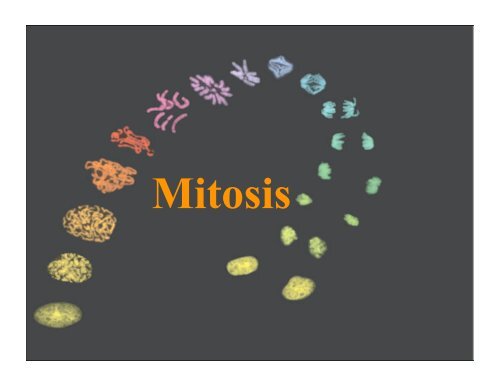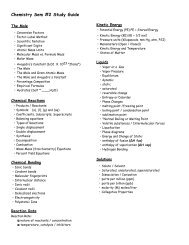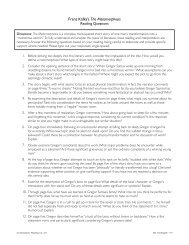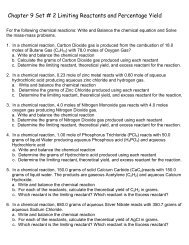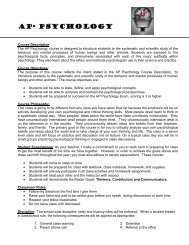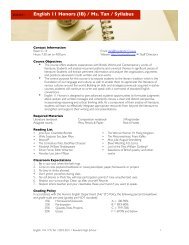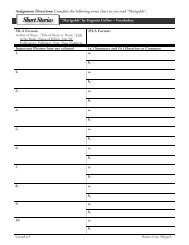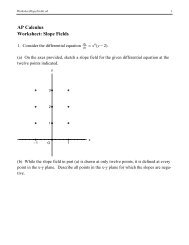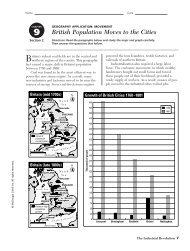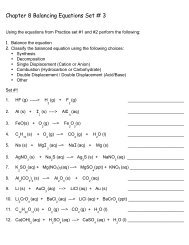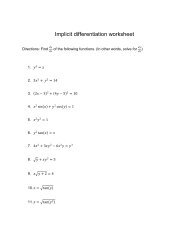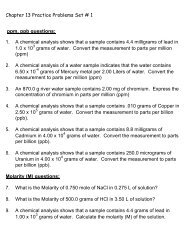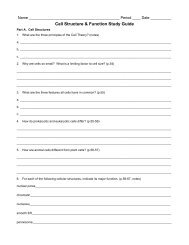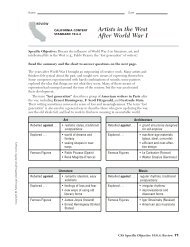Mitosis keypoint.pdf
Mitosis keypoint.pdf
Mitosis keypoint.pdf
You also want an ePaper? Increase the reach of your titles
YUMPU automatically turns print PDFs into web optimized ePapers that Google loves.
<strong>Mitosis</strong>
<strong>Mitosis</strong><br />
(Cell division)<br />
Primary purpose is to increase the<br />
number of cells which are<br />
genetically identical to the parents<br />
Important in growth and repair<br />
<strong>Mitosis</strong> is a continuous process<br />
which is divided for convenience
DNA Replication<br />
DNA must be<br />
copied or<br />
replicated<br />
before cell<br />
division<br />
Each daughter<br />
cell will receive<br />
an identical copy<br />
of the DNA<br />
Original DNA<br />
strand<br />
Two new,<br />
identical DNA<br />
strands
Parent cell<br />
Chromosomes are<br />
copied and double<br />
in number<br />
Chromosomes<br />
now split<br />
2 daughter cells<br />
identical to original
Chromosome =<br />
DNA + protein<br />
(visible light microscope)<br />
Chromatin =<br />
DNA + protein<br />
DNA
• Chromatin: uncoiled DNA and Protein. It’s how<br />
DNA exists when not dividing
Chromosomes vs. Chromatin<br />
Chromosomes<br />
• Tightly packed, coiled<br />
DNA<br />
• Found only during cell<br />
division<br />
• Consists of sister<br />
”chromatids” attached at a<br />
centromere<br />
Chromatin<br />
• Uncoiled DNA<br />
• Found throughout<br />
Interphase
Chromosomes in Dividing Cells<br />
Before division,<br />
chromosomes<br />
replicate.<br />
Duplicated<br />
chromosomes are<br />
called<br />
chromatids &<br />
are held<br />
together by the<br />
centromere<br />
Called Sister Chromatids
Though<br />
chromosomes<br />
are<br />
basically DNA,<br />
much of this<br />
structure<br />
consists of<br />
protein<br />
Form by<br />
replication
How Long is a Chromatid a<br />
Chromatid<br />
A chromatid is a chromatid as long as it is held in<br />
association with a sister chromatid at the centromere<br />
Centromere<br />
Chromatid<br />
Chromosome<br />
Chromatid<br />
When two sister chromatids separate (after<br />
metaphase) they go from being chromatids to being<br />
two different chromosomes
Most eukaryotic cells have between<br />
10 and 50 chromosomes in their<br />
nuclei<br />
Human body cells have 46<br />
chromosomes or 23 identical pairs
Cell Cycle<br />
During the cell cycle, a cell grows,<br />
prepares for division and divides to<br />
form 2 daughter cells, each of which<br />
then begins the cycle again<br />
Interphase – time for growth and<br />
regular cell activity. Most of a cells<br />
life is spent in Interphase
• The cell cycle<br />
consists of two<br />
distinct phases<br />
– Interphase<br />
– <strong>Mitosis</strong> phase<br />
(DNA synthesis;<br />
chromosome duplication)<br />
Interphase<br />
(90% of time)<br />
Mitotic<br />
phase (M)<br />
(10% of time)<br />
<strong>Mitosis</strong>
<strong>Mitosis</strong><br />
Is the division of “somatic” or regular<br />
body cells<br />
It’s divided into 4 phases but,<br />
remember Interphase is NOT part of<br />
<strong>Mitosis</strong>
Four Mitotic Stages<br />
Prophase<br />
Metaphase<br />
Anaphase<br />
Telophase
Interphase<br />
<br />
<br />
<br />
<br />
Sometimes called the<br />
“resting stage” between<br />
divisions, but not a true<br />
stage of mitosis<br />
BUT cells are<br />
metabolically very active<br />
The amount of DNA in the<br />
nucleus doubles<br />
New organelles such as<br />
mitochondria are made.
Interphase-continued<br />
No chromosomes are<br />
visible<br />
The chromosome<br />
material, chromatin,<br />
is spread through-out<br />
the nucleus, but the<br />
DNA has replicated
Prophase<br />
*The longest stage<br />
Chromatin coils-up &<br />
becomes visible--now<br />
called chromatids<br />
In animal cells, the<br />
centrioles divide and<br />
move to opposite<br />
ends of the nucleus<br />
Nuclear membrane &<br />
nucleolus disappears
Prophase-continued<br />
Protein microtubules<br />
develop from each<br />
centriole forming<br />
spindle fibers.<br />
(In plant cells there are<br />
no centrioles and the<br />
spindle forms<br />
independently)
Prophase-continued<br />
Towards the end of<br />
prophase each<br />
chromosome can be<br />
seen to consist of two<br />
chromatids held<br />
together by a<br />
centromere.
Metaphase<br />
Chromatids (replicated<br />
chromosomes) line up<br />
on the equator of the<br />
cell---(equatorial<br />
plane)<br />
Spindles attach<br />
themselves to the<br />
chromatids at their<br />
centromere<br />
“Middle Metaphase”
Anaphase<br />
The chromatids<br />
separate and move to<br />
opposite ends of the<br />
cell.<br />
They are now referred<br />
to as chromosomes<br />
once again.<br />
“Split Away in<br />
Anaphase”
Anaphase--continued<br />
This movement results<br />
from the contraction<br />
of the spindle fibers,<br />
which shorten and pull<br />
the chromatids apart.
Telophase<br />
Chromosomes uncoil<br />
A nuclear membrane<br />
forms around each<br />
group of chromosomes<br />
Spindle disappears<br />
(is essentially the<br />
opposite of Prophase)
Telophase--continued<br />
The chromosomes<br />
uncoil and are now in<br />
the chromatin state<br />
The cytoplasm divides<br />
by cytokinesis
CYTOKINESIS<br />
Animal cells<br />
The center of the cell<br />
‘pinches in’ to form a<br />
cleavage furrow<br />
Two separate<br />
(identical) cells result
Cytokinesis is different in plants & animals<br />
Cleavage furrow<br />
in animal cell<br />
Cell plate in<br />
plant cell
Animal<br />
Plant
CYTOKINESIS<br />
Plant cells<br />
Vesicles produced by the Golgi body collect<br />
on equator of cell<br />
These vesicles fuse to form a cell plate<br />
The cell plate eventually stretches right<br />
across the cell forming two cells<br />
Cellulose builds up here to form a new cell<br />
wall
CYTOKINESIS
Interphase<br />
Nucleus defined<br />
DNA still chromatin
Prophase<br />
DNA coils-up<br />
Nucleoli disappear<br />
Mitotic spindle forms
Metaphase<br />
Centrosomes opposite poles<br />
Equatorial plane<br />
Chromatids at middle<br />
Spindle apparatus<br />
Brief phase
Anaphase<br />
Chromatids now chromosomes<br />
“Sisters” split away to opposite<br />
poles
Telophase<br />
“Sisters” at opposite poles<br />
Chromosome uncoils<br />
Cytokinesis already under way
Interphase<br />
Chromatin<br />
Nucleolus<br />
Nuclear<br />
envelope<br />
Plasma<br />
membrane
Prophase<br />
Metaphase<br />
Early<br />
mitotic<br />
spindle<br />
Centromere<br />
Chromosome, consisting<br />
of two sister chromatids<br />
Spindle<br />
microtubules<br />
Spindle
Anaphase<br />
Telophase and Cytokinesis<br />
Nucleolus<br />
forming<br />
Cleavage<br />
furrow<br />
Nuclear<br />
envelope<br />
forming<br />
Chromatid separating
<strong>Mitosis</strong> (first half)
<strong>Mitosis</strong> (second half)
Rat – epithelial cells
<strong>Mitosis</strong> – bone cell<br />
slides<br />
1 2<br />
3<br />
Parent cellchromatin<br />
4<br />
Chromosomes visible<br />
5<br />
Cells<br />
split<br />
Chromatids line-up<br />
Chromatids split<br />
2 daughter cells
Plants
Review:<br />
Interphase<br />
Name this<br />
Telophase<br />
Prophase<br />
Name this<br />
Anaphase<br />
Metaphase
Eukaryotic Cell Division<br />
Prophase Metaphase Anaphase Telophase<br />
Cytokinesis
<strong>Mitosis</strong> in Onion Root Tips<br />
Do you see any stages of mitosis
Name the Stages of <strong>Mitosis</strong>:<br />
Early Anaphase<br />
Early prophase<br />
Metaphase<br />
Interphase<br />
Early<br />
Telophase,<br />
Begin<br />
cytokinesis<br />
Late<br />
Prophase<br />
Late telophase,<br />
Advanced<br />
cytokinesis<br />
Mid-Prophase<br />
Late<br />
Anaphase


